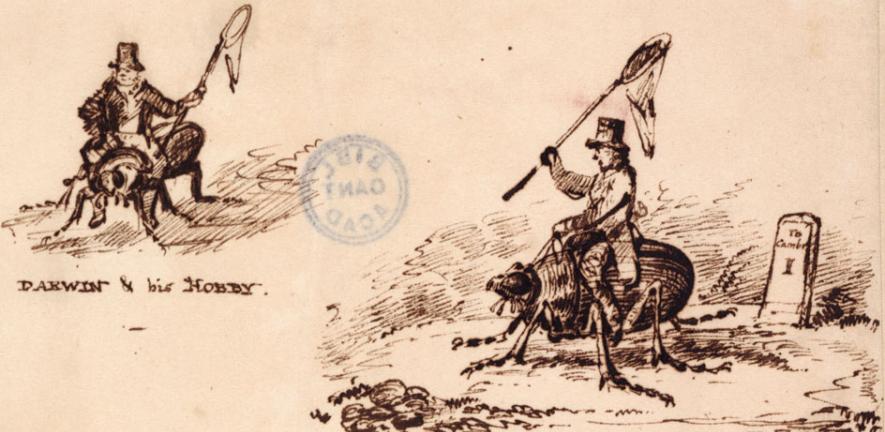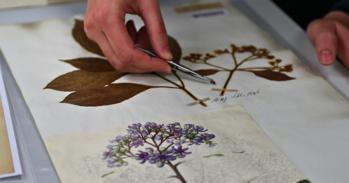
Through the Darwin Correspondence Project, a rich collection of letters held at Cambridge University Library is both transforming our understanding of one of the greatest scientists of the 19th century and providing a panoramic vision of the era in which he lived.
Through the Darwin Correspondence Project, a rich collection of letters held at Cambridge University Library is both transforming our understanding of one of the greatest scientists of the 19th century and providing a panoramic vision of the era in which he lived.
Crucial bits of information are gradually fitted together, each informing and being informed by another.
Two centuries after his birth, Charles Darwin is probably one of the most famous scientists who ever lived, and certainly the most controversial. Yet, far from being the isolated genius of legend, Darwin was a prolific correspondent, who used letters very much as we use email. They were the lifeblood of his research. His correspondence provides us with a remarkable record of intellectual development, from his voyage around the world on HMS Beagle, to the decades formulating and honing his theories. They also provide a window onto his extraordinary global network of informants – the Victorian men and women who provided him with observations on the fauna, flora and peoples of the world: from gardeners, nurserymen, geologists and naturalists, to diplomats, army officers, novelists and suffragettes. They offer a remarkable picture of civil discussion and reasoned debate, from which we would do well to learn.
Today, the world’s largest archive of Darwin’s correspondence, together with his notes, manuscripts and annotated books and periodicals, is housed in Cambridge University Library (www.darwinproject.ac.uk/). The richness of this resource has made the Library an international centre for studies of Darwin and 19th-century science. Scholars from all over the world regularly visit the manuscripts room and communicate with its expert staff. They also depend on the Library’s collection of 19th-century books and scientific periodicals, unrivalled in its accessibility and extent.
These remarkable resources have led to an ambitious project, now in its 35th year and planned to continue until 2025: to publish a comprehensive chronological edition of all known letters, both to and from Charles Darwin, wherever they might be in the world.
Building and interpreting an archive
The bulk of the collection was given to the Library by the Darwin family and the Pilgrim Trust in 1942, and since then materials have continued to be added. Work on publication of the letters began in 1974, with a team led by an American scholar, Frederick Burkhardt, with the aid of Sydney Smith, a zoologist in the University of Cambridge. The first 10 years were occupied solely by searching worldwide for any letters the team could find and putting them into initial chronological order – less than half of the known letters have a date written on them.
A total of almost 15,000 letters exchanged by Darwin with nearly 2000 correspondents, spanning the period from 1821 until his death in 1882, have now been located, some in libraries and some in private collections. One letter even turned up on a recent broadcast of the BBC’s Antiques Roadshow. About 8000 are in Cambridge, including important materials on deposit from the Down House Trust.
Each letter requires painstaking transcription, retaining all original spellings (and mis-spellings!), followed by annotation. Crucial bits of information are gradually fitted together, each informing and being informed by another. The result gives not just a new perspective on the 19th century, but fundamental insights into our own controversies about science and religion, the nature of evolution, and issues in ecological science. In this way, the meticulous research required to annotate the letters becomes the starting point for further understanding.
All the letters are being published in chronological order in the complete edition of the Correspondence of Charles Darwin by Cambridge University Press, of which the 17th of a planned total of 30 volumes will be published this summer. The letter transcripts and notes are also made freely available in a searchable online database five years after printed publication (www.darwinproject.ac.uk). As new letters come to light, or as new information on their contents or dating becomes available, the database is revised. The aim is to provide a unique, comprehensive and reliable source of information on his correspondence, as well as major topics in Darwin’s life and work.
Funding – past and future
A project on this scale requires commitment from funding partners who understand the importance of supporting accessible, innovative research carried out to the highest standard over many years. Contributions from private donors have been essential for the research to progress, as well as long-term support provided by the Andrew W. Mellon Foundation, British Ecological Society, Isaac Newton Trust, John Templeton Foundation, National Endowment for the Humanities, and National Science Foundation. Funding is currently being sought for the next phase of work.
For more information, please contact Professor Jim Secord, Director (jas1010@cam.ac.uk), and Dr Alison Pearn, Assistant Director (ab55@cam.ac.uk), of the Darwin Correspondence Project.
Darwin after On the Origin of Species
The Darwin Correspondence Project is entering a new phase: the letters to and from Darwin as he formulated his thoughts on the descent of man.
Publication of On the Origin of Species in 1859 is often presented as the climax of Darwin’s career. In fact, it was only a beginning. Darwin knew that once he had gone public with his theory of evolution by natural selection, much more would be demanded of him. Twenty-three years of astonishing scientific productivity ensued, and in that time Darwin’s correspondence grew phenomenally.
One of the topics barely touched on in Origin was the evolution of man. Darwin had always planned to include a chapter on humans, but left it out lest it led to unnecessary controversy. During the later years of the 1860s, accused of concealing his opinions, Darwin began to gear up for a full-scale assault on the citadel. Where did humans come from? Why are there different sexes? Why do races differ from one another? Are there characteristics – language, music, morals, rational thought – that decisively separate humans from the rest of the animal kingdom?
The Correspondence Project has now reached the moment when these fascinating questions come to the fore. Tackling human origins with the same tools that had proved so successful in understanding the rest of nature, Darwin extended his global network of correspondents, making enquiries among missionaries, soldiers, merchants, diplomats and travellers. The result, The Descent of Man, and Selection in Relation to Sex, appeared in two volumes in 1871, and a closely related work, The Expression of the Emotions in Man and Animals, was published in the following year.
In producing the volumes of letters dealing with Descent and Expression, the Project has plans for an extensive programme of supporting research, focused on the issues of race, gender and human nature. Work on this phase will be carried out through a new association between the Correspondence Project and the History of Science Department at Harvard University, where the work will be led by Professor Janet Browne, author of an award-winning two-volume biography of Darwin. This exciting transatlantic initiative aims to open up new perspectives on what is, by any standard, among the most significant episodes in modern history.
This work is licensed under a Creative Commons Licence. If you use this content on your site please link back to this page.





